Shoes
Wrinkle Chaser
Unusual job: A wrinkle chaser uses a hot-air jet to 'chase' wrinkles out of leather boots and shoes. This is done using a wrinkle chaser machine.
Tacoma News Tribune - Jan 6, 1957
Posted By: Alex - Sun Aug 15, 2021 -
Comments (1)
Category: Jobs and Occupations, Shoes
Double-Sided Cowboy Boots
From fashion label Hood by Air. Introduced in 2016. Not sure if it's still possible to buy them anywhere.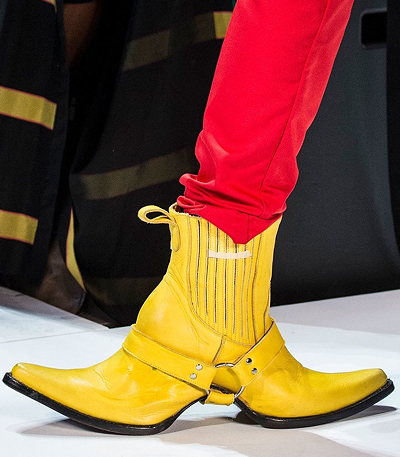
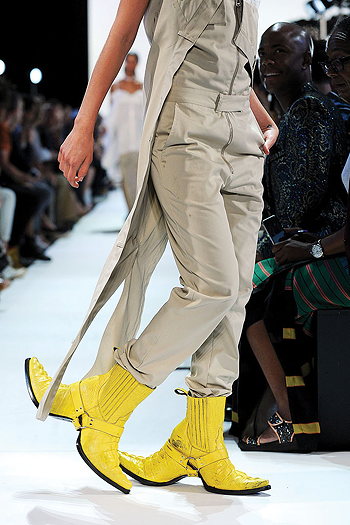
source: footwearnews.com
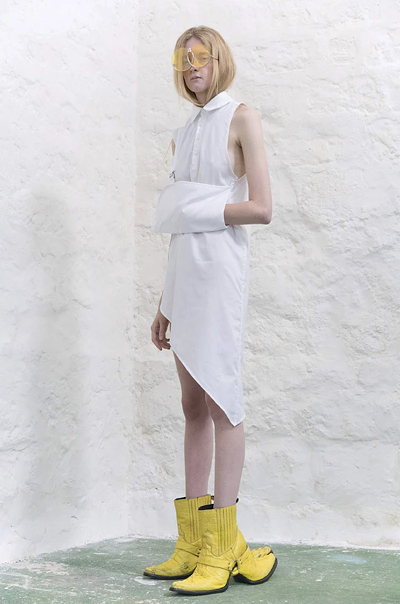
source: i-d.vice.com
Posted By: Alex - Mon Aug 09, 2021 -
Comments (6)
Category: Shoes
Urine-Collecting Shoe
Problem: you're out in public and really need to go to the bathroom, but there are no toilets around.Solution: the urine-collecting shoe, patented by Ran Rahimzada in 2008.
As described in his patent:
According to the present invention, a new shoe includes a container to store a person's urine. The person may use a standard catheter, which is connected to the container in the shoe.
This is an unobtrusive device, there is no bag attached to one's foot, etc. The device may be used discreetly, without attracting undue attention.

Posted By: Alex - Sun May 30, 2021 -
Comments (1)
Category: Inventions, Patents, Body Fluids, Shoes
The Coward Shoe
In 1866, cobbler James S. Coward opened a store in New York City. He named it after himself, and he referred to the shoes he sold as "Coward shoes".Despite the odd name, his business did extremely well. In fact, it endured almost to the present. As of 2014, the company had both a twitter and facebook page. But their website now redirects to Old Pueblo Traders whom, I'm guessing, must have acquired them.
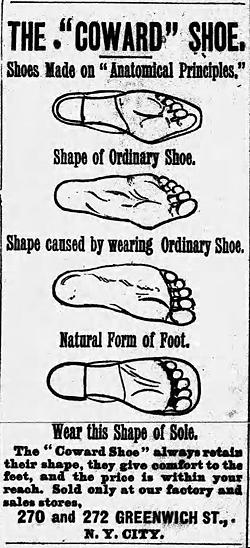
The Keyport Weekly - Apr 23, 1892
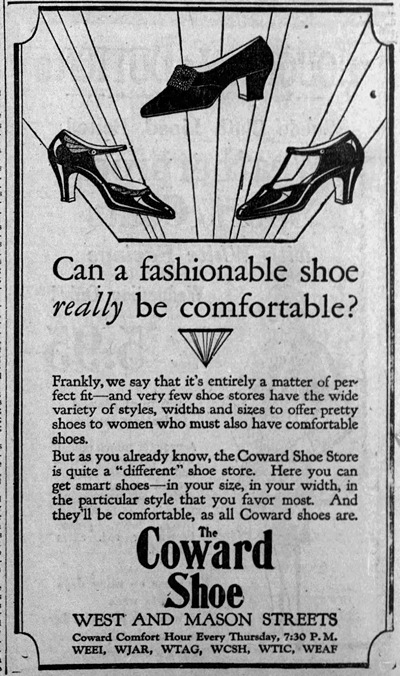
Boston Globe - Sep 20, 1927
Posted By: Alex - Wed Nov 25, 2020 -
Comments (4)
Category: Odd Names, Shoes
The drift pattern of Nike shoes
In May 1990, five shipping containers holding approximately 80,000 pairs of Nike shoes fell off a freighter during a storm in the North Pacific. About 200 days later, some of these shoes began to wash up on beaches from Canada down to Oregon.But as beachcombers collected and compared the shoes, they noticed something odd. On beaches up north, in Canada and Washington, almost all the shoes were right-footed; whereas further south in Oregon, most of the shoes were left-footed.
Skye Moody explains why this was so in her book Washed Up: The Curious Journeys of Flotsam and Jetsam:
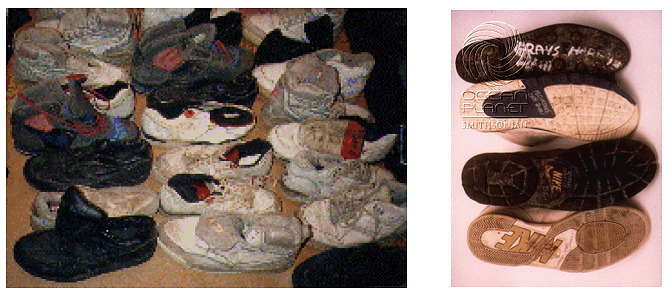
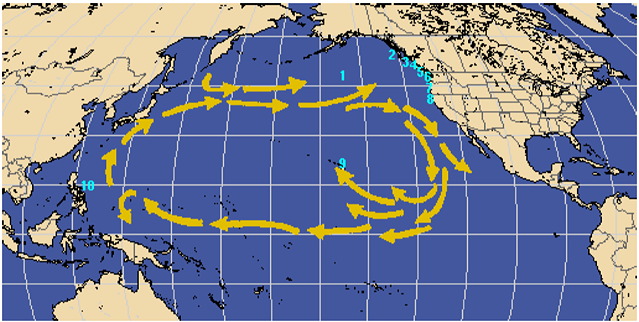
Drift pattern of Nike shoes
image source: The Nike Shoe Investigation
Oceanographer Curtis Ebbesmeyer co-authored an academic paper about the 1990 shoe spill ("Shoe spill in the North Pacific" -- unfortunately behind a paywall). It also inspired him to start studying other ocean flotsam, such as rubber duckies, as a way to gain info about currents. He calls this study 'flotsametrics'. He also occasionally puts out a Beachcombers' Alert Newsletter.
Posted By: Alex - Tue Jun 16, 2020 -
Comments (0)
Category: Science, Shoes, 1990s
Social Distancing Shoes
Created by Romanian shoemaker Grigore Lup. More info from footwearnews.com:
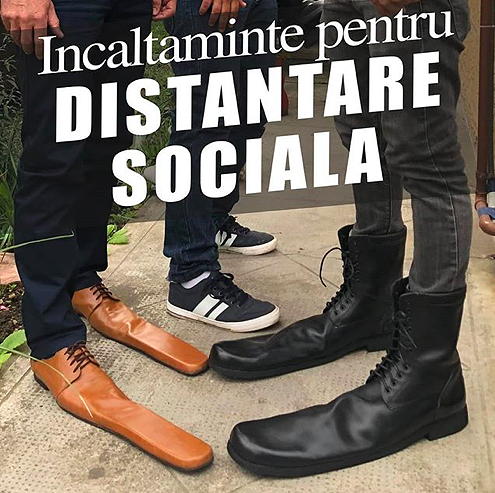
Posted By: Alex - Fri Jun 05, 2020 -
Comments (8)
Category: Shoes
Shoe Gongs
Anthony Faranda of Yonkers, NY worried that children didn't like wearing rubber-soled shoes because they made no noise when walking on a pavement. So, he invented a shoe gong. Or, as he called it, a "footwear actuated noise maker." He patented it in 1957.It was a disc and clapper that could be worn over shoes. He explained: "The arrangement is such that upon normal walking steps or running strides the clapper is activated to make noise and thereby promote the interest of children in wearing shoes with soles that do not make an audible sound in engaging firm or rigid surfaces."
Maybe kids would have liked these, but not, I imagine, their parents.
He assigned the patent to the NY advertising agency McCann-Erickson. It's unclear what plans they might have had for these things.
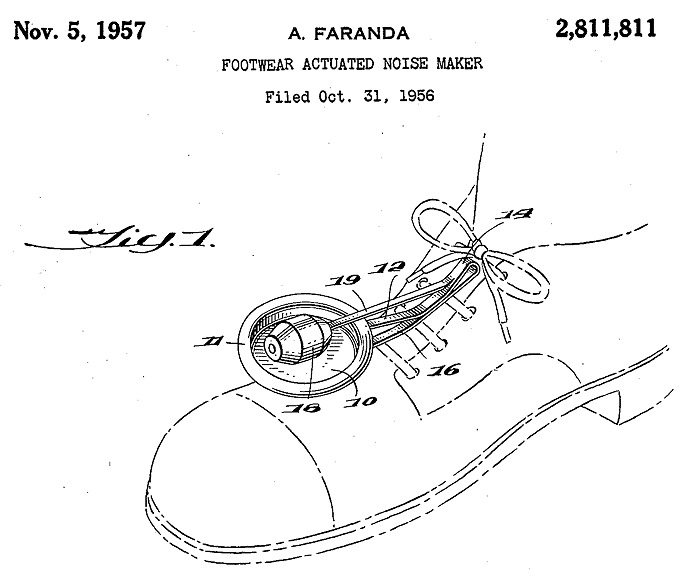
Posted By: Alex - Sun Feb 16, 2020 -
Comments (2)
Category: Inventions, Patents, Shoes, 1950s
Gaming Shoes
Newly released by Puma: "Active Gaming Footwear" — so that your shoes don't hold you back while you're playing computer games.Some of the touted benefits:
Lateral wrap-up support in ATTACK mode
Heel wrap-up stability in CRUISE and DEFENSE mode
I have no idea what any of that means (though I'm not a gamer... maybe it would make perfect sense if I was).
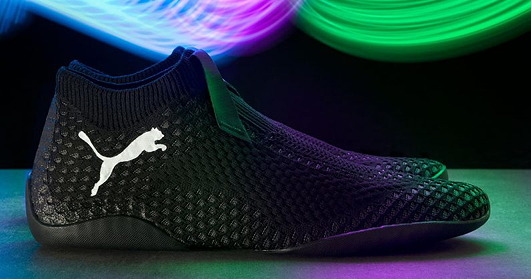
Posted By: Alex - Sat Dec 21, 2019 -
Comments (4)
Category: Shoes
Slimming Insoles
Created by Dr. Robert Metz, Slimming Insoles were advertised as “the first and only massage insole in the world which reduces weight and regulates the digestion system.”Here’s a link to the 1997 FTC complaint against Metz and his company. It noted that, “In truth and in fact, scientific studies do not demonstrate that Slimming Insoles cause significant weight loss without changes in diet or exercise."
And yet, Slimming Insoles are still being sold. I'm not sure if Dr. Metz himself is selling them. But you can buy some at Amazon, and they make specific claims about causing weight loss: "These slimming magnets emit magnetic waves which weaken fat cells in your body... Lose weight by walking with magnetic insoles."
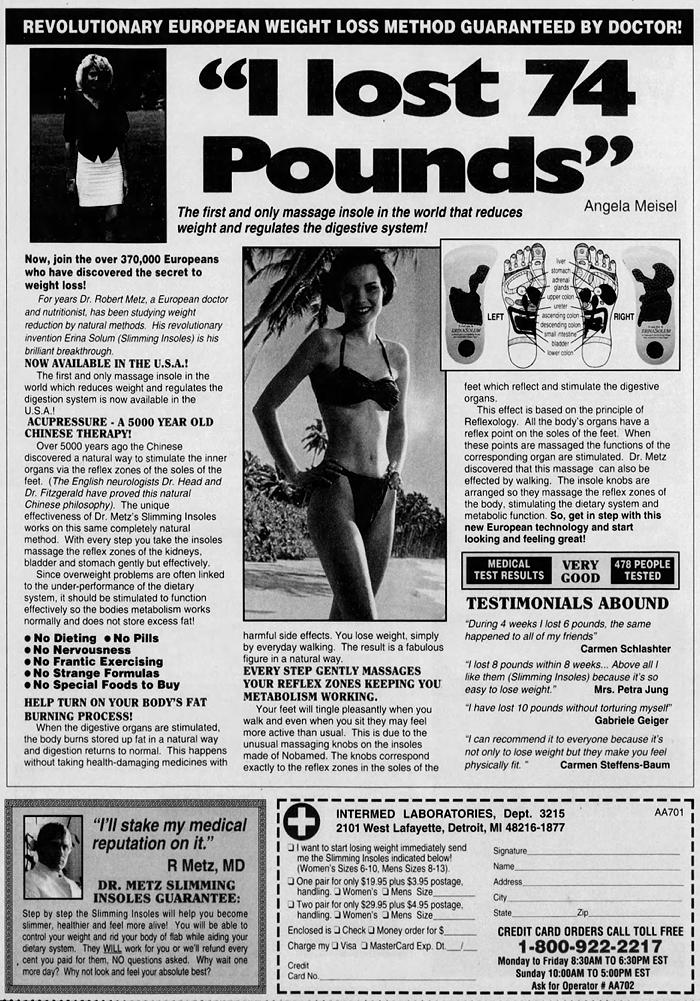
St. Louis Post-Dispatch - Mar 3, 1996
Posted By: Alex - Wed Dec 04, 2019 -
Comments (1)
Category: Shoes, 1990s, Dieting and Weight Loss
An improved container for shoe polish
Carl Herold of Pittsburgh didn't think it made sense to sell shoe polish in tin containers, because the containers were so expensive that they added substantially to the cost of the shoe polish. So, back in 1872, he came up with a solution, which he patented: pack shoe polish in animal guts.Figure 1 is an elevation of a package of blacking put up in accordance with my invention. Fig. 2 is a transverse section thereof...
The blacking is packed in suitable lengths of animal guts A, which are then firmly tied up at both ends, presenting the appearance of a sausage. Each package should be wrapped in paper to prevent the grease or oil upon the outer surface of the package from soiling the hands in handling it. The blacking thus packed will retain its moisture, and consequently remain in a proper plastic state for a great length of time. In this condition it may be sold by the pound, each purchaser or user providing himself with a small saucer or other shallow vessel into which to empty portions of the package from time to time for use.

Posted By: Alex - Sun Dec 01, 2019 -
Comments (0)
Category: Inventions, Patents, Shoes, Nineteenth Century

| Who We Are |
|---|
| Alex Boese Alex is the creator and curator of the Museum of Hoaxes. He's also the author of various weird, non-fiction, science-themed books such as Elephants on Acid and Psychedelic Apes. Paul Di Filippo Paul has been paid to put weird ideas into fictional form for over thirty years, in his career as a noted science fiction writer. He has recently begun blogging on many curious topics with three fellow writers at The Inferior 4+1. Contact Us |




